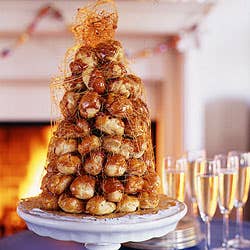
Towering Cream Puffs
Croquembouche—an edible monument of caramelized pastry—is a real mouth-cruncher.
The fine arts are five in number," wrote the legendary French chef Marie-Antoine Careme, "to wit: painting, sculpture, poetry, music, architecture—whose main branch is confectionery." He certainly knew what he was talking about. The reigning master of pieces montees, the elaborate edible centerpieces that towered over European banquet tables in the 18th and 19th centuries, Careme employed a variety of cookies, pastries, fruits, and nuts for his creations. His croquembouche—which literally means "crunch in the mouth" for reasons that become obvious when you chomp down on this extravagant caramel-crusted dessert—was no exception. Careme made his croquembouches in many different sizes and shapes and with many different combinations of materials, but every element was always coated in a thin layer of cooked sugar, sometimes caramelized (Careme-elized, as it were) or tinted with saffron or cochineal (a red dye). Then, he applied his favorite glue—more cooked sugar—to stick everything together. In Careme's hands, the croquembouche could be a tiered, roughly conical arrangement, but he once boasted of using a type of sugar-coated pastry to fashion "ruins, cottages, bridges ... baskets, shrubs, terraces, ancient temples and colonnades"—with, we might add, the help of a mold or two. Today, the croquembouche is always conical and usually made of cream-filled pastry puffs. Careme's garnishes, like nougatine (a brittlelike mix of almonds and caramel), marzipan, and—our favorite—a crowning swirl of caramelized sugar, can still top it off. Ribbons and flowers of pulled sugar are a more contemporary addition, but this is high-tech pastry making. We prefer to keep things simple. And, surprisingly, making croquembouche is simple. Once you get it—fill the choux, dip the choux, glue the choux—you've got it.
Keep Reading
Continue to Next Story










